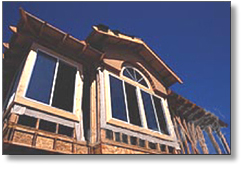How Do the 2006 Residential and International Energy Codes Stack Up?
 Every three years, organizations responsible for updating construction codes publish new ones. Thatís the case with the International Energy Conservation Code and the International Residential Code. Both were updated in 2006.
Every three years, organizations responsible for updating construction codes publish new ones. Thatís the case with the International Energy Conservation Code and the International Residential Code. Both were updated in 2006. When the Nebraska Legislature updated the stateís energy code in 2004, it established the 2003 International Energy Conservation Code as the Nebraska Energy Code. While the legislation did not provide for automatic updating of the energy code, the Legislature authorized the Energy Office to allow alternatives to the 2003 code, if energy use under an alternative code was the same or less.
Since several code jurisdictions in the state asked about substituting the 2006 International Energy Conservation Code or the 2006 International Residential Code for the 2003 code, the Energy Office commissioned a study,Energy Impact Study of the 2003 IECC, 2006 IECC, and 2006 IRC Energy Codes for Nebraska PDF to analyze
 the differences in the codes and determine if the newer codes saved more energy. These codes were compared in Omaha, Chadron and Norfolk and for houses with 12 percent and 18 percent window-to-wall area ratio. The 2006 International Energy Conservation Code and the 2006 International Residential Code have nearly identical requirements when applied to the homes in this study. These two codes allow builders two options for exterior wall construction, both of which were studied.
the differences in the codes and determine if the newer codes saved more energy. These codes were compared in Omaha, Chadron and Norfolk and for houses with 12 percent and 18 percent window-to-wall area ratio. The 2006 International Energy Conservation Code and the 2006 International Residential Code have nearly identical requirements when applied to the homes in this study. These two codes allow builders two options for exterior wall construction, both of which were studied.Why Are Energy Codes Important in New Construction?
Energy codes establish minimum insulation requirements for both commercial and residential buildings. Residential codes provide insurance to homeowners that newly constructed homes make use of modern techniques and products that make houses energy-efficient. By complying with energy code requirements, energy bills are lower and comfort levels are often improved. Codes also level the playing field for builders by requiring a standard level of quality in areas that homeowners might not see when they are buying a house such as the insulation in the walls.

The Findings
The analysis indicated the 2003 International Energy Conservation Code performs best in most cases. Homes constructed according to the requirements of the 2003 International Energy Conservation Code consumed less energy annually for heating and cooling in the Chadron and Norfolk climates in all cases. The 2003 International Energy Conservation Code also consumed the least energy in Omaha for houses with an 18 percent window-to-wall ratio.
The 2006 International Energy Conservation Code/International Residential Code consumed less energy in Omaha for houses with a 12 percent window-to-wall area ratio. Based on the those results, the author of the analysis, Dr. Amy Musser, expects the 2006 International Energy Conservation Code/International Residential Code will consume less energy for Omaha houses with up to 15 percent window-to-wall ratio. Above 15 percent, the 2003 International Energy Conservation Code will result in less energy consumption.
Differences Between 2003 and 2006 Codes
There are several key differences between the 2003 and 2006 International Energy Conservation Codes:
- Under the 2003 code, Nebraska was divided into four separate climate zones with different insulation requirements for each. The 2006 code combines the entire state into a single climate zone with uniform requirements. The 2006 insulation requirements are most similar to the 2003 requirements for Omaha, which has one of the stateís warmest climates. For this reason, the 2003 code results in less energy use in Chadron and Norfolk, which have colder climates.

- A second difference is that the 2003 International Energy Conservation Code requires more insulation to be used when houses have a larger percentage of windows. This acts both as an incentive for builders to limit the percentage of windows and to partially offset the increased energy consumption that occurs as the amount of window area increases. The 2006 International Energy Conservation Code drops this requirement. There is no limit on the window area that can be installed, and there is no longer a requirement to offset the energy consumed by the larger window area with increased insulation elsewhere in the house. For this reason, the houses in Omaha with 18 percent window-to-wall ratio used less energy under the 2003 International Energy Conservation Code.
- A third difference is the 2006 code allows builders to use less insulation in ceilings and floors if the insulation fills the framing cavity. This potentially allows houses to be constructed with much less insulation than the 2003 code allows. These lower insulation values were not used in this study, but even without using them, the 2003 International Energy Conservation Code used less energy in most cases.
As with all studies, assumptions were made and parameters such as house size and style were selected for the study.
The cost of the study performed by Dr. Amy Musser, Principal, Vandemusser Design was $4,950 and was paid for with funding from the U.S. Department of Energy. Dr. Musser completed the original study which analyzed the impact of the 2000 International Energy Conservation Code on Nebraska home owners while she was with the University of Nebraska's College of Architectural Engineering. That study was submitted to the Legislature when senators were considering adopting an updated energy code.